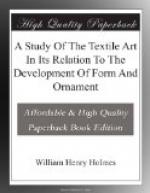[Illustration: FIG. 350. Design painted in color upon a woven surface, exhibiting the full degree of geometric convention. Ancient Peruvian work. Copied from The Necropolis of Ancon.]
So habit and association carry the geometric system into adventitious decoration. When the ancient Peruvian executed a design in color upon a woven surface (Fig. 350), using a pencil or brush, the result was hardly less subject to textile restraint.
As a matter of course, since there are two distinct styles of decorative design—the textile and the free hand—there exist intermediate forms partaking of the character of both; but it is nevertheless clear that the textile system transforms or greatly modifies all nature motives associated with it, whether introduced into the fabric or applied to its surface.
In countries where the textile art is unimportant and the textile system of decoration does not obtrude itself, free hand methods may prevail to such an extent that the geometric influence is but little felt. The Haidah Indians, for example, paint designs with great freedom and skill, and those applied to woven surfaces are identical with those executed upon skins, wood, and stone, but this art is doubtless much modified by the means and methods of Europeans. Our studies should be confined wholly to pure indigenous art.
EXTENSION OF TEXTILE ORNAMENT TO OTHER FORMS OF ART.
I have now dwelt at sufficient length upon the character of the textile system of ornament and have laid especial stress upon the manner in which it is interwoven with the technical constitution of the art. I have illustrated the remarkable power of the art by which decorative elements from without, coming once within the magic influence, are seized upon and remodeled in accordance with the laws of textile combination. Pursuing the investigation still further it is found that the dominion of the textile system is not limited to the art, but extends to other arts. Like a strong race of men it is not to be confined to its own original habitat, but spreads to other realms, stamping its own habits and character upon whatever happens to come within its reach. Its influence is felt throughout the whole range of those arts with which the esthetic sense of man seeks to associate ideas of beauty. It is necessary, before closing this paper, to examine briefly the character and extent of this influence and to describe in some detail the agencies through which the results are accomplished. First and most important are the results of direct transmission.




